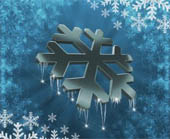
Purpose
To demonstrate the growth of crystals in reaction to water temperature by creating homemade snowflakes.
Additional information
Snowflakes are crystalline water ice, formed when super cooled cloud droplets hit freezing temperatures. Molecules from the droplets join together by chance to create a random arrangement around a nucleus. A snowflakes shape is determined by environment, including temperature and humidity at the time the snowflake forms. A common misbelief is that no two snowflakes are ever alike, with random patterns forming in a manner that is virtually impossible to replicate. Although unlikely for two macroscopic object to contain identical molecular structure, there is no scientific fact that proves snowflakes cannot be identical. In fact, it can be argued that snowflakes formed at the same condition and within close proximity may in fact take on identical characteristics. In 1988 Nancy Knight of the National Center for Atmospheric Research discovered identically matching snow crystals in Wisconsin, disproving that identical snowflakes are an impossibility.
Sponsored Links
Required materials
- Wide mouthed glass jar
- Piece of string or thread
- Scissors
- Water
- Saucepan
- Pencil
- Pipe cleaners, preferably white but multi-colored are fine.
- Borax (aka: sodium borate). Do not use Borax soap!
- Food coloring
Estimated Experiment Time
About 20 minutes to create your snowflake and 24 hours or more for it to form.
Step-By-Step Procedure
- 1. Cut your pipe cleaners into 3 equal lengths.
- 2. To form a six-sided flake, twist the pipe cleaners together at their center. Don't worry if the shape isn't perfect.
- 3. Tie one end of the string to the top of your snowflake. Tie the other end to the center of the pencil. The length of the string should be long enough so the snowflake can dangle in the jar without touching the bottom. Trim your string as needed to get the desired length. Do not place the snowflake in the jar at this time.
- 4. Measure several cups of water and pour into the jar (keep note of how many cups you use). There should be enough water to fill the jar about 3/4ths full, or high enough that the snowflake will be completely submerged when added to the jar.
- 5. Pour the water from the jar into a saucepan and bring to a boil.
- 6. Once boiled, carefully pour the water back into the jar.
- 7. Add 3 teaspoons of borax to every cup of water in the jar. Each teaspoon of borax should be added one at a time and stirred until it dissolves. So, if you used 3 cups of water you would stir in 9 teaspoons of borax one at a time until each dissolves.
- 8. Add food coloring to your snowflake solution (optional).
- 9. Suspend the snowflake inside the jar by laying the pencil across the mouth of the jar. The snowflake should be dangling in the center of the jar without touching the bottom and should be completely submerged by your snowflake solution.
- 10. Place the jar in a location where it will remain undisturbed for at least 24 hours.
- 11. After the 24 hours has passed, crystals have grown on your pipe cleaners and formed a very cool looking snowflake!
Note
For this experiment we formed a six-sided snowflake. Once you get the process down, you can be more creative with your snowflakes and cut your pipe cleaners into a multitude of shapes and twist them together in any way you think looks cool.
Observation
Why do you think the crystals formed on the pipe cleaner? If you didn't have Borax powder, do you know of any alternatives that may produce similar results? For example, how do you think the experiment outcome would differ if you used sugar instead of Borax? What if you used salt?
Result
Borax (sodium borate) is made up of soft colorless crystals that are easily dissolved in water. When the molecules from the boiling water expand and move further apart, the borax powder is allowed to dissolve to saturation. The snowflake begins to form when the solution begins to cool, causing the molecules in the water to contract and move closer together. The pressure caused by the contracting of the molecules causes the forming borax crystals to cling and form on the pipe cleaners. As the water releases the excess crystals and begins to evaporate, the snowflake takes its form.
Sponsored Links
Take a moment to visit our table of Periodic Elements page where you can get an in-depth view of all the elements,
complete with the industry first side-by-side element comparisons!